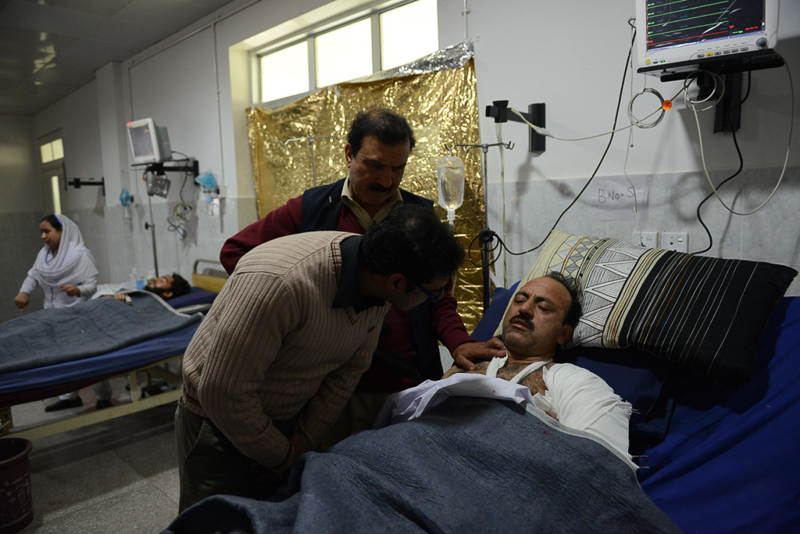
Peshawar: While many will remember 2007 as the year Pakistan lost Benazir Bhutto to a terrorist attack, it is another terrorist attack that haunts Shams Suleman, a doctor at the Lady Reading Hospital in Peshawar.
Suleman was on duty at the General Intensive Care unit when the hospital received scores of victims in the wake of suicide attack on Eid prayers congregation in Sherpao village of Charsadda district. The then interior minister, Aftab Ahmed Khan Sherpao, was the target, who narrowly escaped life attempt. Over 50 people lost their lives in the suicide attack while another 96 were injured.
The chaos at the Lady Reading Hospital Peshawar — the largest tertiary care hospital of Khyber Pakhtunkhwa province — when the attack victims were brought in was something doctors expected. However, it was the “uncalled-for” presence of media-persons on December 21, 2007 that seemed to get in the way of the medic’s quick response to an emergency where lives depended on it.
“To put it in a word, it is irresponsible,” says Suleman. “At a time when seriously injured patients need doctors’ complete attention, the media-persons start distracting the medical staff from the task at hand by making videos and photographs of the victims and that too without the permission of victims and doctors.”
He says it is harassment at the hands of media. “All hospitals should be made off-limit for media-persons during emergencies. They should only go to the office of the focal person appointed by the hospital authorities to get any information they need.”
The media coverage of the victims of Army Public School attack on December 16, 2014, at Peshawar’s Lady Reading Hospital (LRH) is a classic example of unethical reporting, says Shareef Ahmad Khan, the administrative head at the hospital.
“On the fateful day of December 16, we, on one hand, were faced with a terribly difficult task to provide medical treatment to terror victims and on the other, the cameramen, photographers and reporters proved a major hurdle in our work,” recalls Khan.
The media-persons, he says, even try to interview on-duty doctors busy providing medical treatment to badly-injured victims. “At times they even push doctors and para-medics to make room to shoot footage victims in the trauma hall of the hospital.”
According to the hospital staff, visitors have a lot of germs in their throats and hands, which may infect victims with open wounds. The overcrowded environment at the trauma hall, they say, may deteriorate the condition of the patients.
Apart from the problems media-persons create for the staff of the hospitals, on-the-spot coverage also have deep psychological impact on those who see blood-splattered bodies on their television screens.
“It’s a sort of horror movie, only its true, which has a very negative impact on people, especially our kids,” says Inayatur Rahman, a Peshawar-based lawyer.
Prof. Syeda Farhana Jahangir, former vice-chancellor of Shaheed Benazir Bhutto Women University Peshawar and a senior clinical psychologist, agrees with Rahman. “People would not go out of their houses almost three weeks after the school attack,” she says, adding that children also see the gory footage, which has a long-lasting psychological impact on their minds.
Jehangir says exposing children to such visuals and photographs leads anxiety, depression and lack of confidence. “This is called post-traumatic stress disorder. Its effects on a human mind come after a trauma and they are persistent.”
Nasir Malik, news director of Capital TV, says that it is an established fact that television is a medium of visuals. He says that the television channels instruct local teams on coverage of incidents at hospitals but they never pressurize the reporters to ask questions to the victims as they lie bleeding.
“Even the thought of it repels,” says Malik. “It will only lead to more trauma.”
About Standard Operating Procedures (SOP) for media-persons to cover such incidents, he says, “Yes I agree that all TV channels and their senior staff including director news and controller news should chalk out clear parameters [for coverage of such places].”
Malik believes that SOPs would be helpful to avert the media’s siege of hospitals during emergencies as it would become a joint responsibility of all newspapers and TV channels not to throng hospitals and other crime scenes.
“This will put an end to competition for breaking news and ultimately media-persons would come to respect the privacy of victims,” he says.
For Inayatur Rahman shooting TV footage of somebody at a hospital’s bed is akin to trespassing into one’s privacy, which violates Article 14 of the Constitution.
“I think that our media is subjecting its viewers to mental torture by screening footage of gruesome incidents. They should be confined only to give facts and figures,” he says.
Abdul Majeed Goraya, a Peshawar-based photojournalist who has covered scores of terror incidents both at the spots and hospitals, does not support journalists’ presence at trauma halls and hospital wards where victims are treated.
“Victims need immediate care and we just descend on the hospitals with our heavy equipment like vultures,” he says.
Like Malik, he also suggests a joint strategy so that the competition for breaking news and to be first to make photos available on the wire could be discouraged. “I personally don’t want to go to hospitals for coverage because at hospitals we take photos at the expense of people’s lives,” says Goraya.



